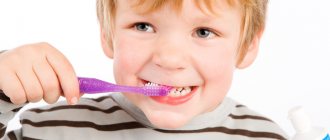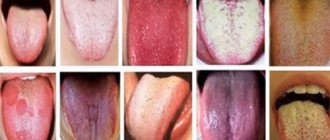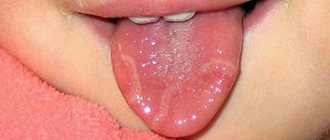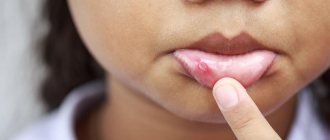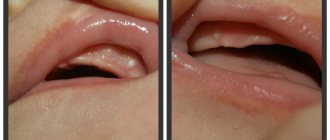What could be the reason
Bad breath in children is the result of processes that occur in the oral cavity or inside the body. The main cause of the unpleasant odor is pathogenic bacteria that actively multiply and create a special microflora.
Possible causes of bad breath in children.
- Poor nutrition. Products such as garlic, onions, etc. are not considered in this case, since the appearance of a strong aroma after eating them is normal. A pathological odor is considered to be one that arises from bacterial microflora that forms plaque on the teeth after eating. For example, sour foods or sweets.
- Poor oral hygiene. The most common reason is that children not only do not like to brush their teeth, but also often do not do this procedure thoroughly enough. The smell may appear due to a large accumulation of plaque.
- Dental diseases. “Odor” from the mouth of children can be a symptom of caries, gingivitis, periodontitis, stomatitis and other pathologies of the teeth or gums.
- Accumulation of plaque on the tongue. If a child brushes his teeth thoroughly, the tongue often remains unattended. At the same time, it is on the tongue that a large number of bacteria can accumulate, which, under favorable conditions, will actively multiply and emit an unpleasant odor.
- Respiratory tract infections. By analogy with the defeat of the oral mucosa by pathogenic microbes, bacteria can multiply in the nasopharynx, maxillary sinuses, tonsils, etc. In this case, the risk of a purulent process cannot be excluded.
- Gastrointestinal diseases. Often an unpleasant odor from a child’s mouth is the result of a malfunction of the pancreas. In rare cases, this symptom indicates problems with the stomach or intestines.
Before you begin to take action, it is necessary to establish the reasons why your child’s breath smells.
Why does my child have a toothache?
Despite the fact that pediatric dentistry is now very developed, we do not lag behind either our European or American colleagues, a lot of hygiene and preventive means are available, many parents do not attach due importance to the health of baby teeth.
Misconceptions of parents:
- there is no need to go to the pediatric dentist if nothing hurts;
- a child of 3-6 years old can brush his teeth himself (although he cannot wash his hair himself);
- You don’t have to treat baby teeth; if they hurt, we’ll remove them. It's still temporary.
For such parents, a child’s complaint of tooth pain is always a surprise. Often these are holidays or all evening.
Let's figure out why baby teeth hurt and what to do if a child has a toothache and how to relieve the pain.
Baby teeth in children are indeed different from permanent teeth. They are more fragile and vulnerable, as they have a different structure and enamel thickness. But they have a complete structure. Roots, nerves, vessels. The enamel is thinner, there are more blood vessels. This means that they collapse faster and become inflamed stronger and brighter.
Very often, caries and pulpitis in children are initially asymptomatic. Their presence can be detected during examination and after X-ray diagnostics.
Such asymptomatic pulpitis can be cured quickly, in one visit, preserving the living pulp in the roots. This is a very good method; root resorption will be more physiological.
Only local anesthesia can be used (an injection into the gum near the tooth).
If the carious cavity is deep, the tooth decay is large, the child has complaints (the tooth hurt from the cold for a long time, it hurt at night, I had to take painkillers), then it will no longer be possible to leave the pulp alive in the canals, it will be inflamed. During treatment, you will have to remove the entire pulp completely (as in adults) and fill the canals with calcium paste, since the roots will dissolve and the paste along with them.
It is not always possible to complete such treatment in one visit, since it is difficult for a child to spend so much time in a chair. Nitrous oxide sedation is often used because the treatment is lengthy and it is difficult to numb a severely inflamed pulp.
The child complains for 1-2 days, but the parents do not attach any importance to this.
Then pulpitis turns into periodontitis. This is when the nerve has already died, pus appears and the inflammation goes deeper. This happens in 2 HOURS!!! You see how fast!
Edema (flux) in children develops right before their eyes, and facial asymmetry appears within a day. This is inflammation of the periosteum (periostitis) and inflammation of the bone itself (osteomyelitis).
In such a situation, urgent tooth extraction and antibiotics are indicated.
With such an acute process and the presence of pus, it is impossible to numb the pain around the tooth on an outpatient basis, as we do during treatment. Pus interferes with the action of the pain medication.
In this case, removal of a baby tooth occurs only under general anesthesia!!!!!!
Our dear parents:
- Help your children care for their baby teeth, and clean the back teeth and hard-to-reach places yourself!
- Bring your child for preventive examinations without waiting for his complaints. Remember, complaints appear very late, and often we do not have time to save the tooth.
- Remember, a child who started meeting the dentist with toothache and gumboil has a more difficult time adapting to dental treatment
- If your child tells you that they have a toothache, DO NOT IGNORE them. Give Nurofen in an age-appropriate dosage and immediately make an appointment with a pediatric dentist. Remember, pulpitis turns into periodontitis in 2 hours.
- Do not refuse to use nitrous oxide or general anesthesia, since it is sometimes impossible to make acute pulpitis painless or remove an inflamed tooth, no matter how much we want.
- The health of your child is in your hands. Prevention is always cheaper and more pleasant than treatment. The dentist will always teach you how to care for children’s teeth and select the necessary means for prevention so that your child will never know what a toothache is.
Differences and features of bad breath
Depending on the cause, bad breath in children may have specific manifestations that are characteristic of the development of certain pathologies.
What smell, what does it indicate?
- Acetone. It is the result of the accumulation of acetoacetic acid and acetone in the child’s body. This symptom is considered quite dangerous, since it may be a sign of tachycardia, urolithiasis or diabetes.
- Putrefactive. Characteristic of the symptoms of ENT diseases, esophageal disorders and some dental diseases (caries, periodontitis, etc.).
- Sour. A sign of gastritis, disturbances in the level of acidity or other pathologies of the functionality of the pancreas.
- Rotten. A symptom of improper functioning of the gastrointestinal tract, which may be associated with the accumulation of hydrogen sulfide in the stomach. Rotten breath also occurs in children with kidney or liver diseases.
- Acetic. The aroma of vinegar occurs with intestinal dysbiosis, dysfunction of the pancreas and periodontal disease.
- Purulent. The appearance of purulent odor from the mouth is a serious sign, which in most cases signals the occurrence of a hidden purulent process inside the tissues of the teeth or even internal organs.
- Sweet. Appears in children with liver diseases, more often with cirrhosis of the liver.
- Chlorine. The aroma of bleach can indicate the progression of periodontal disease and bleeding gums.
Against the background of high temperature in children, due to severe overheating, active reproduction and then decomposition of bacteria occurs, which form pathological mucus - pus or sputum. It is these secretions that often accompany acute respiratory diseases, in which purulent breath is the norm.
Aphthous stomatitis: symptoms
Symptoms will largely depend on the form of the disease:
- Acute aphthous stomatitis is accompanied by a sharp increase in temperature to 38-39 degrees, decreased appetite, increased salivation, and the appearance of bad breath. The main and most characteristic symptom is the formation of redness and grayish ulcers (ulcers) on the oral mucosa with a pronounced inflamed rim. Ulcers are painful, and the pain intensifies when eating food (especially salty, spicy or sweet).
- Chronic aphthous stomatitis in children occurs in a milder form with periodic relapses (recurrent), during periods of exacerbation the symptoms are the same as in the acute form of the disease. At the stage of remission, the ulcers heal quite quickly, in severe cases they scar, and the scars then have to be additionally treated with absorbable agents.
Is aphthous stomatitis contagious? It is believed that in any form it is not contagious, but it is possible for adults to infect a child - by licking baby spoons or nipples, for example, or by not thoroughly washing children's toys, which the child then puts into his mouth.
What measures to take
Bad breath in children should not be ignored. Diseases inside the tissues of the oral cavity and internal organs can occur without significant symptoms, and such a seemingly insignificant symptom allows you to consult a doctor in a timely manner and begin the necessary treatment.
If you experience bad breath, it is recommended to contact a pediatric dental clinic. The specialist will examine the oral cavity, prescribe a diagnosis and, if the development of oral diseases is confirmed, carry out treatment. Often, to combat bad breath from a child, it is enough to start brushing your teeth properly and change your diet.
If, based on the diagnostic results, the specialist suspects the development of pathologies of internal organs or the respiratory system, the doctor will give the necessary recommendations and refer the patient to a more specialized specialist.
Stomatitis in children
Stomatitis is an inflammatory disease of the oral mucosa. Most often it affects infants and preschoolers, less often it is diagnosed in older children.
Causes
The main cause of stomatitis in children is considered to be decreased immunity. This is due to the fact that children and preschoolers have thinner oral mucosa, which is easily injured, and cannot yet effectively resist pathogens (the microflora of the oral cavity is very diverse and subject to significant fluctuations).
Stomatitis in children can be caused by:
- viral, fungal or bacterial infection;
- allergic reaction to toothpaste, food, etc.;
- injury to the oral mucosa during eating, using pacifiers, toys;
- taking certain medications (antibacterial or sulfa drugs);
- diseases of the gastrointestinal tract, blood system, helminthic infestations, endocrine and nervous disorders (so-called symptomatic stomatitis), etc.
Unfavorable factors that increase the risk of the disease include prematurity, wearing braces, insufficient oral hygiene, deficiency of vitamins and microelements (zinc, selenium, folic acid, etc.).
Clinical picture
Symptoms of stomatitis in children depend on the causative agent of the disease. Thus, the viral variety is characterized by the appearance of vesicles (bubbles), which quickly open, leaving in their place small areas of erosion with a fibrinous coating. Such elements can be single or merge into conglomerates, are very painful, accompanied by severe redness of the mucous membrane of the palate, tongue, cheeks, lips, and larynx.
The bacterial variety of stomatitis, in addition to erosions, is manifested by bad breath, the formation of yellow crusts in the affected area, and an increase in body temperature.
Candidal stomatitis, caused by fungi of the genus Candida, most often occurs in children under 3 years of age. It can be suspected by bad breath, the child’s complaints of an unpleasant taste, dryness and a burning sensation in the mouth. Allergic stomatitis can develop from contact with certain foods or unsuitable toothpaste. Symptoms of the disease (redness, swelling and soreness of the mucous membrane) disappear when contact with the allergen is avoided.
Diagnosis and treatment
The presence of stomatitis in children is determined by examining the oral cavity. In order to identify the pathogen, in some cases the doctor prescribes laboratory tests (bacterial culture of a smear from the oral mucosa, etc.).
Treatment of the disease is carried out using local and systemic drugs. During this period, it is important to exclude foods that can irritate the oral mucosa and rinse with solutions recommended by your doctor after each meal.


